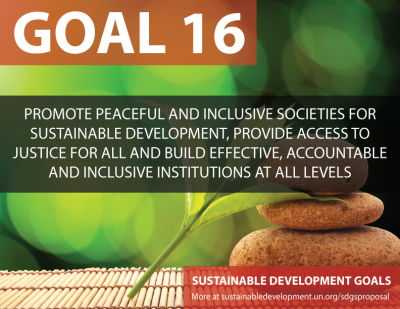The inclusion of a goal to promote peaceful and inclusive societies in the new post-2015 development agenda marks the significant awareness that peace and security is critical for poverty eradication and sustainable development. However, concerns have been raised over how to measure progress toward such a goal and how to translate universal targets and indicators at the national level. With the highest number of targets (10) and the lowest number of means of implementation (2), is SDG number 16: The pursuit of peace, justice, and good governance, destined to remain the stuff of idealistic hopes and Ms Universe aspirations? Or is there a practical role for business?
A common critique of the Millennium Development Goals (MDGs) is that they were too limited in scope, failing to consider the root causes of poverty related to peace, security, and inclusive societies. However, these issues are often at the root of development challenges and at the forefront of international headlines.
During the last 15 years we have witnessed a rise in terrorist attacks all over the world; the Arab Spring, ongoing conflict in Gaza, the rise of terrorist groups in Iraq, Syria, and parts of Africa; several mass shootings and incidents of civil unrest in America, and most recently the refugee crises in Europe. According to the OECD, of the seven countries unlikely to meet a single MDG by the end of 2015, all have been affected by high levels of conflict and violence in recent years.
Sadly, the world as a whole has become incrementally less peaceful in the last decade. The Institute of Economics and Peace’s 2015 Global Peace Index Report finds that “the world is less peaceful today than it was in 2008. It is becoming increasingly divided with some countries enjoying unprecedented levels of peace and prosperity while others spiral further into violence and conflict.”
It’s complicated
There is no doubt that the inclusion of this goal in the SDGs is significant. It can even be argued that SDG 16 is the most important goal, without which none of the other goals can be sustained. However, SDG 16 is also just as complex as it is significant.
It’s tempting to view peace, security, and governance as complex political issues that fall squarely in the purview of governments and security agencies, or as issues specific to ‘conflict–zones’. In fact, in the initial 2013 SDG Draft for public consultation, the goal of peace and security was not included. It was thought to be beyond the scope of the SDGs and a matter for the Security Council of the United Nations.
However, SDG 16 isn’t just about ending wars and reducing the incidence of violence. In addition to two targets on reducing violence, SDG 16 also has a focus on important drivers of conflict including access to justice, corruption and bribery, transparency, fundamental freedoms and participatory decision-making. These drivers of conflict are often activated when various actors, be it governments, societal factions, or even corporations seek to enforce ideologies or acquire resources and power. Herein lies the opportunities for non-government actors.

What does SDG 16 mean for business?
The UNGC agrees that whilst the primary responsibility for ensuring peace and security rests with governments, there is a strong case for businesses to play an active role in supporting SDG 16. Not in the least because businesses cannot thrive in turbulent societies and social instability can be disruptive to global markets. As Melissa Powell, Head of Business for Peace at the UN Global Compact points out, ‘social strife and violent conflicts disrupt production, sales and investment.’ The UNGC reports that in 2014, global economic losses due to violent conflict amounted to over US$9.8 trillion.
At a practical level companies can make significant contributions through business practices by incorporating conflict-sensitivity, fair and responsible resource acquisition, and robust governance mechanisms into their corporate strategies.
Such frameworks and strategies should consider the following:
- Corporate policies, commitments, and actions to address issues such as human rights violations, bribery and corruption, equal access and opportunities for jobs, benefits, safety and security. These are well within the scope of responsible corporate governance – even in the absence of strong government regulations.
- Companies need to be aware of their social and environmental impacts in the communities where they operate – particularly in their acquisition or use of natural resources such as land, water, oil, minerals, and so forth.
- Companies should minimise the unintended consequences their presence have in local and host communities. They have to take it a step further and ensure they add value in areas like employment, skills development, and inclusion in their supply chain.
- Companies can create economic opportunities through shared value initiatives. Collaborations and partnerships along the supply chain help to ensure benefits are fairly shared and reinvested in communities.
- Businesses can promote pro-active and enhanced stakeholder engagement during the planning and execution of projects, promoting participation and inclusivity in decision-making. Transparency and honesty in communication with stakeholders is further needed to help build trust and accountability.
These measures, according to a joint UNGC–PRI publication on Responsible Business Advancing Peace, are likely to enhance risk management, strengthen long-term operations, support a social license to operate and enable a company to manage its reputation more successfully.
Whilst SDG 16 may seem like a daunting goal – still needing further guidance on how to operationalize and measure supporting indicators – failure is not an option. Peaceful and inclusive societies are as much a means as an end to achieving all the other goals. The herculean nature of this task means that it has to be all hands on deck – including governments, NGOs, businesses, and communities.
You can view Corporate Citizenship’s full SDGs 2015 blog series here.

